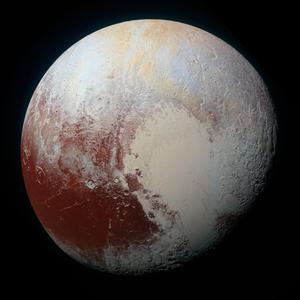Glossary term: Pluto
Description: Pluton est l'un des corps célestes de notre système solaire. Il est situé dans la ceinture de Kuiper, au-delà de l'orbite de Neptune. Elle était connue comme la neuvième planète du système solaire, mais en 2006 elle a été reclassée comme planète naine. Elle a été découverte en 1930 par Clyde Tombaugh. La distance moyenne de Pluton au Soleil est de 6 milliards de kilomètres (km), et son rayon est de 1 185 km (plus petit que la Lune). Une année sur Pluton équivaut à 247,9 années terrestres et son jour équivaut à 6,4 jours terrestres.
La mission New Horizon de la NASA a été le premier vaisseau spatial à survoler Pluton, en 2015, et a fourni la toute première vue détaillée de la surface de la planète et de son atmosphère. La surface de Pluton est si froide que très peu d'hydrogène peut exister sous forme gazeuse. Le peu d'atmosphère que possède Pluton est principalement composée d'azote, et la surface présente de grandes plaines d'azote gelé. Son atmosphère s'étend jusqu'à une distance de 1600 km. Pluton est composée de roches (70%) et de glace (30%). Elle possède cinq lunes connues : Charon, Styx, Nix, Kerberos et Hydra.
Related Terms:
See this term in other languages
Term and definition status: The original definition of this term in English have been approved by a research astronomer and a teacher The translation of this term and its definition have been approved by a research astronomer and a teacher
The OAE Multilingual Glossary is a project of the IAU Office of Astronomy for Education (OAE) in collaboration with the IAU Office of Astronomy Outreach (OAO). The terms and definitions were chosen, written and reviewed by a collective effort from the OAE, the OAE Centers and Nodes, the OAE National Astronomy Education Coordinators (NAECs) and other volunteers. You can find a full list of credits here. All glossary terms and their definitions are released under a Creative Commons CC BY-4.0 license and should be credited to "IAU OAE".
If you notice a factual or translation error in this glossary term or definition then please get in touch.
Related Media
Pluton
Credit: NASA/Johns Hopkins University Applied Physics Laboratory/Southwest Research Institute credit link
License: PD Public Domain icons
Related Activities
Children's Planetary Maps: Pluto & Charon
astroEDU educational activity (links to astroEDU website) Description: Learn about our furthest neighbors
License: CC-BY-4.0 Creative Commons Attribution 4.0 International (CC BY 4.0) icons
Tags:
Maps
, Planetary cartography
, Spatial thinking
, Charon
Age Ranges:
6-8
, 8-10
, 10-12
, 12-14
Education Level:
Middle School
, Primary
, Secondary
Areas of Learning:
Social Research
Costs:
Low Cost
Duration:
2 hours
Group Size:
Group
Skills:
Analysing and interpreting data
, Asking questions
, Communicating information
, Constructing explanations
, Developing and using models
, Engaging in argument from evidence
, Planning and carrying out investigations










